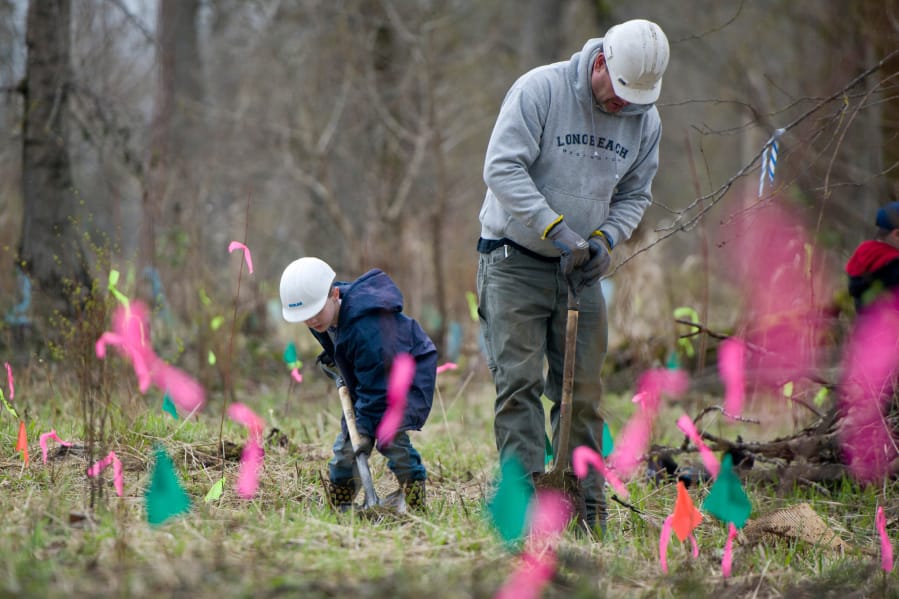WASHOUGAL — Shamrocks? Not so much.
On this St. Patrick’s Day gathering, the focus was on swamp rose and snowberry, willow and dogwood. The event was a habitat restoration project Saturday morning just east of Washougal.
More than 30 participants dug and dibbled in the moist earth at Steigerwald Lake National Wildlife Refuge. Some were members of Cub Scout Pack 450 and their families. Others were volunteers from the Columbia Gorge Refuge Stewards, who show up regularly at the 1,049 acres of wetlands, pastures and woodlands along the Columbia River.
Rick Jones definitely is a regular.
“It’s a great place,” Jones said. “I live in Washougal. I come here three or four times a week, so I decided I might as well do something while I’m here.”
Saturday’s group walked almost a mile from the parking lot to the work site, where Andy Bauer explained the day’s mission. They were planting native species near the water to counter the invasion of reed canary grass.
If You Go
What: Steigerwald Lake National Wildlife Refuge.
Where: On state Highway 14 east of Washougal, near mile marker 18.
When: Open daily during daylight hours. Closing times for the automated gate are posted on the entrance gate.
Cost: Free
On the Web: www.fws.gov/refuge/Steigerwald_Lake/
“It was brought here from Europe to feed dairy cattle,” said Bauer, an environmental educator with the Lower Columbia Estuary Partnership, which organized the event.
Teams of two or three volunteers then picked up shovels and dibbles — pointed tools used to poke holes in the ground for seeds and small plants — and went to work.
It was challenging in spots. Deaglan McGrath, 7, was among the Cubs who jumped up and came down with both feet on their shovels, trying to make a dent in the soil.
After the shovel work was done, they picked up an appropriate plant for that spot.
Pacific red willow and red twig dogwood create shade for the creek and lake, enhancing fish habitat.
Douglas spirea, swamp rose, snowberry and red elderberry provide food and nesting materials for birds and habitat for insects that eventually will feed the lake’s fish.
Once the trees were planted, there was another important task, and it involved pretty pink plastic flagging tape.
“We tie it on the tree so people can see it,” said Lukas McEiver, an 8-year-old Cub Scout.
Saturday’s outing was the ninth in a series of 10 planting projects organized by the Estuary Partnership from the end of October through March. The season is just about over because they plant bare-root trees.
“Bare-roots are easier, but you can’t do them after it gets warm. They start to leaf out, and you want them to be dormant,” volunteer coordinator Sam Dumont said.
The Portland-based organization brought about 600 plants to Steigerwald Lake.
“We overplant, so it will look really dense,” she said. However, “We don’t put up protectors or water them, so we will have some die-off.”
It all helps, said Thomas Hall, 15. He was working with Alexa Talvitie, 18, who was doing a community service project for her environmental biology class at Clark
“I’ve done a couple of plantings,” Hall said, and he knows that not everything thrives. “Even if a couple do, it makes a difference.”
Hall pointed to a couple of adolescent cottonwoods behind him.
“Someday those …” Hall said, then turned and pointed at two mature trees, “will be these.”




